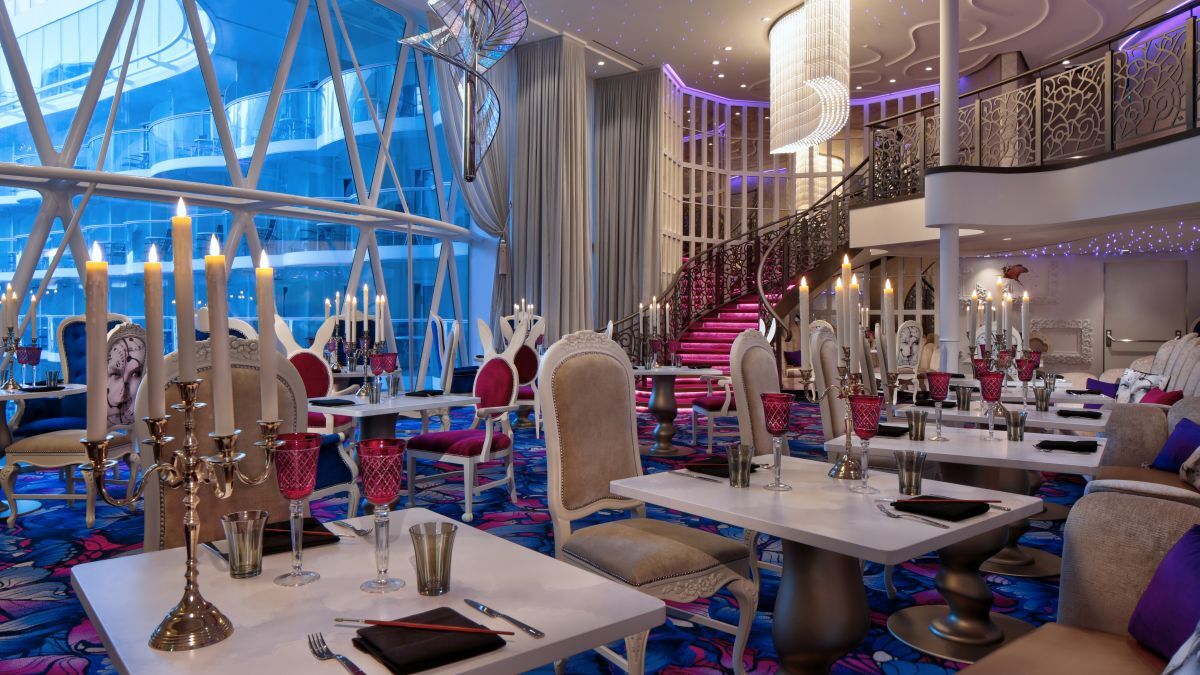Wonderland speciality restaurant on Wonder of the Seas has a menu based around the themes of Earth, fire, ice, sea and sun (source: Royal Caribbean)
Consultant project manager Stephen Fryers explains how the pandemic is still affecting the cruise interiors market, highlights opportunities for innovation, and discusses changes he has seen in the industry since he started out
Can you give me your thoughts on the current cruise ship refurbishment market?
Overall, the market is greatly reduced post pandemic. Several factors are driving this situation: economic losses due to the pandemic, full fleet return to service is not there, and supply chain disruptions for materials. The market will come back, it has to, the ships will eventually need upgrades to keep them looking fresh, plus trends change resulting in venues being refurbished to suit. I believe it will be two to three years before we see the market back to full capacity.
What are the current main trends within cruise ship refits?
Lines are doing basic projects such as carpet changes, drapery upgrades, reupholstery and other smaller works. These can be done relatively cheaply but can have a huge impact on the guest experience while on board. I’m not seeing anyone doing major projects. That is not say larger projects are not in the planning stage for 2023.
Is there any lingering impact from the pandemic on the cruise interiors market, and has it led to any changes?
Absolutely. One lingering impact from the pandemic is related to supply chain disruptions. Everyone is suffering, no one is immune. I hear daily how difficult it is to find materials and products. A lot of the main material suppliers have had issues sourcing the raw materials for their products, so choices are greatly reduced. This has resulted in large cost increases for materials across the board. Shipping of materials is likewise impacted, as is the cost of shipping. Container shipping prices have sky rocketed during the pandemic.
What are the main challenges within the cruise refit market?
The major lines are wanting to do projects. However, they all have some financial constraints due to the pandemic which I am sure is a major challenge. We are talking about refurbishment projects which are important from a guest satisfaction perspective, but there are also a lot of technical projects that require consideration, and these may be given higher priority. You can’t go cruising if the ship is not meeting technical requirements from an operating and safety standpoint.
Are you seeing any particular innovation within the cruise ship refit market?
Innovation is always present, that never changes. It is just a matter of what that innovation might be. I am hearing a lot more talk about ’green’ materials and products, and how the industry can utilise them in projects. Obviously, wherever green materials and products can be used it helps improve the overall environmental impact of the ship. Many suppliers are now providing options of greener materials and products which is helpful when making selections early on in a project. This drive will only increase and become more important on projects in the years to come.
What have been the most interesting projects you have worked on over the last few years and why?
I find all projects interesting. That is one of the beauties of this industry, and especially the refurbishment side of the business. No project is the same, you get to work in so many different venues from staterooms, bars, casinos, restaurants, nightclubs, open deck areas and more. And on each ship, they are different, which is great as it is never boring. Also, when on a drydock, one day to the next is different. Problems arise daily, but they are never the same problem.
Since the start of your career in the cruise industry, what have been the main changes you have seen within the interiors market and what are your thoughts on how this market has developed?
One big difference I have witnessed is the professionalism of how projects are now planned and executed. When I first came into the industry, drydockings were not always as well organised and executed as they are nowadays. Things have changed greatly in this respect with many lines now having dedicated departments to plan and execute large-scale and technically challenging drydockings. The same could be said of the supplier base, and consultants whom over the same period have become more professional in their ways of operating and doing business. This has been a positive change for the industry.
What do you think we are going to see in terms of developments and trends within this market in the next two years?
That is a big question, and I don’t have an answer. Clearly the pandemic has impacted the industry, and I’m sure this will have a knock-on effect in terms of new developments and trends. Just what these will be, and in what semblance, only time will tell. The cruise industry is always developing so you can take it for certain that something will happen.
Box out bio: Stephen Fryers
Stephen Fryers is a native of Ireland who left shortly after university, moving firstly to England. Since then, he has lived and worked in Hong Kong, Australia and Italy. At university he studied architecture and later undertook post-graduate studies in project management. He has been involved in the cruise industry for over 20 years during which time he has been fortunate to have worked on newbuild, refurbishment and major conversion projects for some of world’s leading cruise lines. Mr Fryers’ main area of expertise is in interior fit-out works and he has gained vast experience and knowledge in project managing cruise ship construction projects. He now lives in Florida, mainly because that is where the work is, but also because he dislikes cold weather.






